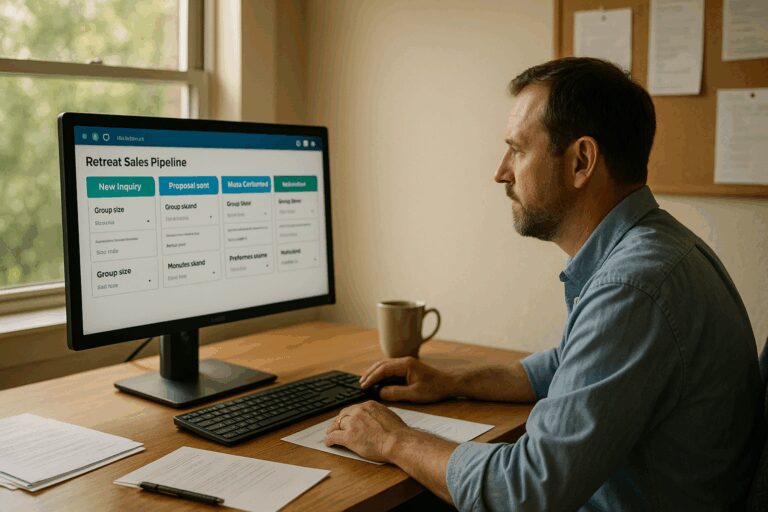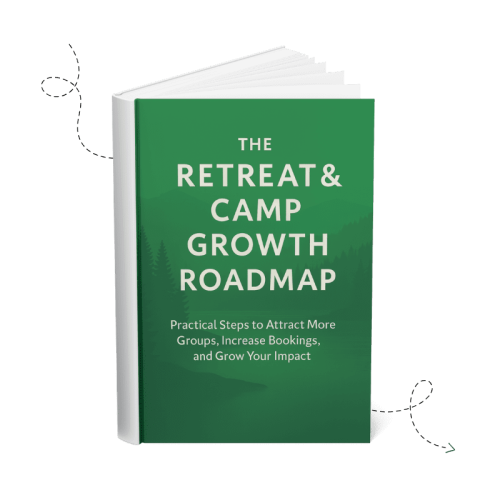Retreat & Camp Growth Roadmap Focus Area: Streamline Pipeline Management
Introduction
Retreat sales pipeline management is critical for converting inquiries into bookings and ensuring a smooth, repeatable process for every group you serve. While many retreat centers know how important it is to attract new inquiries, fewer have strong systems in place for what happens after the inquiry arrives. Without a clear way to track sales, manage retreat details, and follow up on rebooking, staff often rely on scattered emails, spreadsheets, and memory. The result? Missed opportunities, stressful planning, and fewer groups returning year after year.
That’s where CRM automation makes the difference. By setting up automated pipelines inside your CRM, you can progress deals smoothly from inquiry to contract, coordinate retreat details without dropping the ball, and keep rebooking conversations alive. When retreat pipelines are framed around outcome-based stages (like Final Numbers Received or Rebooked), your CRM can automatically advance opportunities as actions are completed—saving time, reducing errors, and giving you clear visibility.
Why This Focus Area Matters
Every retreat group represents people to serve and relationships to steward. But when you don’t have a structured CRM pipeline, leads slip through the cracks, retreat planning becomes chaotic, and rebooking often gets delayed until it’s too late.
A well-designed CRM for retreat centers solves these problems by:
- Capturing every inquiry automatically.
- Progressing opportunities based on outcomes, not memory.
- Triggering reminders when staff action is needed.
- Keeping retreat details in one central system.
When your CRM pipelines reflect real outcomes, your staff spend less time chasing details and more time focusing on ministry.
Is This an Area You Need to Focus on Right Now?
Ask yourself:
- Do inquiries sometimes sit in your inbox without a quick response?
- Do retreat details live in multiple documents instead of one central system?
- Do you rely on staff memory to remember when to follow up for rebooking?
- Does your team struggle to see, at a glance, where each retreat group stands in the process?
If you answered “yes” to any of these, CRM automation can help you track, streamline, and secure more retreats with less effort.
Putting This Focus Area into Practice
Streamlining your pipeline with CRM automation isn’t about adding complexity. It’s about building pipelines that reflect the real-life stages of a retreat journey, using outcome-based stage names that allow automation to take the lead. When a form is submitted, a field updated, or a contract signed, your CRM can automatically advance the opportunity to the next outcome stage. That means every group progresses smoothly, without relying on staff to remember every detail.
To make this practical, imagine opening your CRM dashboard. You see rows of stages—New Inquiry, Call Scheduled, Proposal Sent, Booked, Meals Confirmed, Final Numbers Received, Rebooked. Each group is represented as a card, moving automatically as actions are completed. With one glance, you know exactly where every opportunity stands and what needs attention.
Let’s look at how CRM automation works in three key areas: sales, retreat coordination, and rebooking.
Streamlining the Initial Sales Process
Picture this: it’s Monday morning, and you find three new inquiries—one from your website, one from a voicemail, one from Facebook Messenger. Without a system, you’re digging through emails and sticky notes. With a CRM pipeline, all three are logged instantly, acknowledged automatically, and waiting for you in the same place.
Quick responses don’t just look professional—they dramatically improve your chances of booking. Groups that hear back within 24 hours are far more likely to sign. Your CRM can make that happen every time, without adding more to your plate.
CRM Workflow Example:
- Inquiry received → CRM creates new opportunity in the “Sales” pipeline. Stage = New Inquiry.
- Immediate acknowledgment → Automated email + text reassure organizer that their inquiry is received.
- Internal notification → Booking coordinator is assigned a follow-up task.
- Intro call scheduled → Once booked, stage auto-advances to Call Scheduled.
- Proposal sent → CRM logs the proposal email; stage = Proposal Sent.
- Contract signed → Stage moves to Booked, triggering the coordination pipeline.
Benefit: Because stages are outcomes (Proposal Sent, Contract Signed), the CRM moves deals forward automatically and ensures no lead is lost. That consistency builds trust with group leaders and increases closing rates.
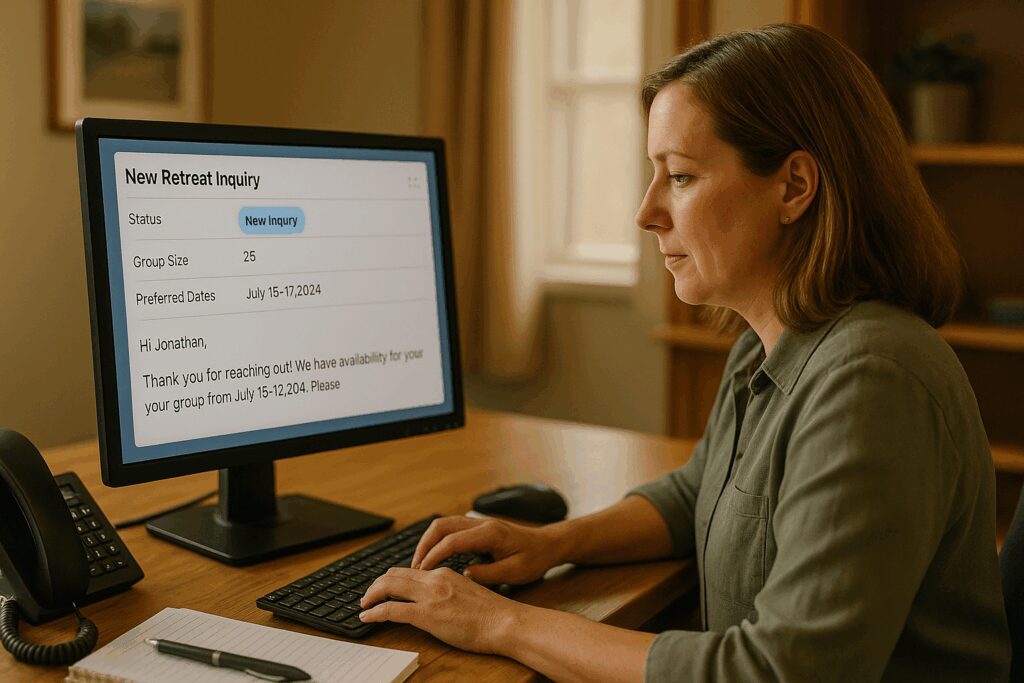
Simplifying the Retreat Coordination Process
Now imagine two weeks before a retreat. The kitchen staff asks how many gluten-free meals to prepare. You realize the organizer never sent that info. You scramble to track them down, adding stress for everyone.
With a CRM “Retreat Coordination” pipeline, this doesn’t happen. Every key detail is captured, reminders go out automatically, and the retreat moves forward stage by stage without guesswork.
CRM Workflow Example:
- Contract signed → Opportunity created in “Coordination” pipeline, stage = Planning Started.
- Welcome packet → CRM sends automated planning guide to organizer.
- Lodging assignments → Organizer submits form; CRM updates lodging fields; stage = Lodging Confirmed.
- Meals & menus → Meal times and menus chosen; dietary fields updated in CRM; stage = Meals Confirmed.
- Meeting rooms & AV → Requests logged; AV staff assigned; stage auto-advances to Meeting Spaces Confirmed.
- Activities scheduled → Activities booked; stage = Activities Scheduled.
- Transportation details → Arrival/departure submitted; CRM fields updated; stage = Transportation Confirmed.
- Final numbers → 14 days before retreat, CRM requests headcount. When organizer submits form or “Final Headcount” field updated, stage = Final Numbers Received.
- Event start → On arrival day, stage auto-advances to In Progress.
Benefit: By tying stages to outcomes, the CRM keeps retreats on track. Instead of chasing details, your team delivers a calm, organized experience that makes groups want to return.
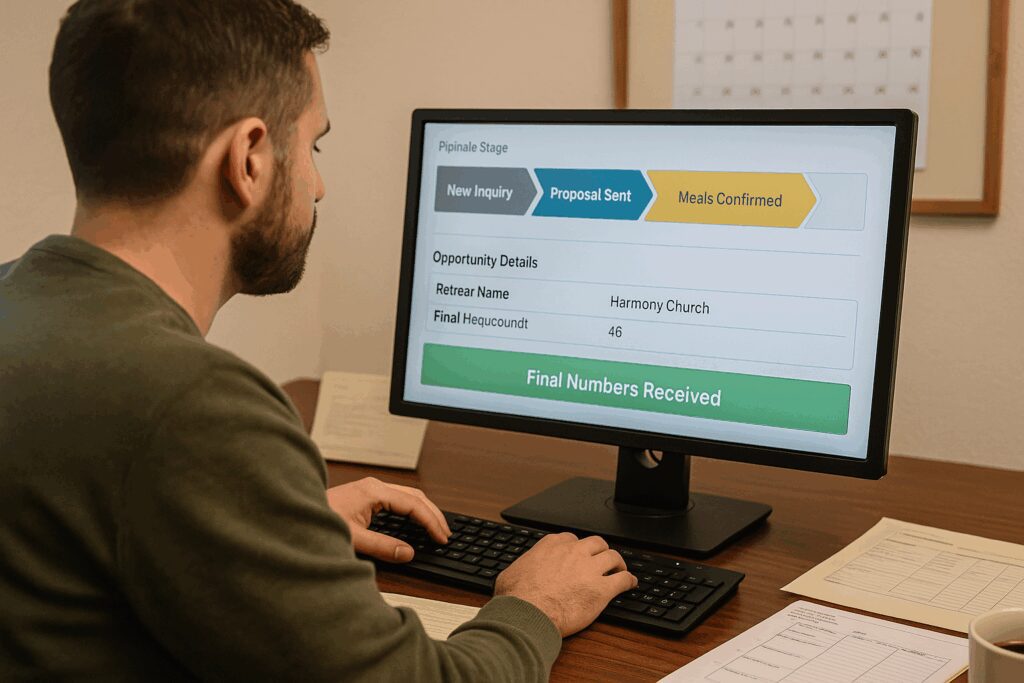
Securing Rebookings Quickly After Retreats
The end of a retreat is the best time to rebook—while the group is energized and grateful. But not every organizer can commit before leaving. Without a system, the follow-up gets delayed until next year.
With a CRM-driven “Rebooking” pipeline, you keep the conversation alive until a clear outcome is reached.
CRM Workflow Example:
- End of retreat → CRM creates opportunity in “Rebooking” pipeline, stage = Ready for Rebooking.
- On-site ask → CRM reminds staff to invite rebooking. If confirmed, stage = Rebooked.
- Thank-you follow-up → Within 48 hours, CRM sends thank-you + survey; staff follow-up task created.
- 30-day reminder → Automated email offers to hold dates; stage = Awaiting Rebooking Decision.
- 60-day escalation → If no response, CRM assigns staff a call task.
- Decision logged → Opportunity marked Rebooked or Closed.
Benefit: By automating follow-up and using outcome-based stages, the CRM ensures no rebooking opportunity slips through the cracks. Groups have multiple touchpoints, and your calendar fills sooner.
Internal Notifications & Pipeline Updates
CRM automation isn’t just about guest-facing emails—it’s also about keeping your team aligned. Pipelines automatically:
- Advance opportunities when outcomes are reached.
- Update fields when forms are submitted.
- Send reminders when staff action is required.
This creates accountability, ensures accuracy, and means no retreat depends on memory alone.
Choosing the Right CRM for Automation
The effectiveness of pipeline automation depends heavily on the CRM you use. While many CRMs can capture contacts and track opportunities, not all are designed with strong automation features. Choosing a platform with robust automation tools ensures your team can move opportunities forward consistently without relying on manual updates.
Some examples of automation capabilities to look for include:
- Automated stage advancement based on outcomes (e.g., contract signed, form submitted, field updated).
- Automated communications such as acknowledgment emails, deadline reminders, and thank-you follow-ups.
- Internal notifications that assign tasks or alert staff when human action is required.
- Field updates that keep critical information current without manual entry.
- Integration with third-party tools so your CRM can work seamlessly with forms, payment systems, email platforms, and more.
Our preferred choice for retreat centers is LeadHub CRM. LeadHub offers robust automation options fully integrated into its CRM, making it easier to build outcome-based pipelines without the need for multiple systems. In addition, LeadHub connects with third-party platforms, enabling two-way automation. That means you can trigger actions in LeadHub when something happens in another system (like receiving a payment) or update external applications based on data or actions inside LeadHub (such as sending registrant information to an email platform).
With the right CRM—like LeadHub—you’ll have the flexibility and power to automate not only your sales pipeline but also your retreat coordination and rebooking workflows.
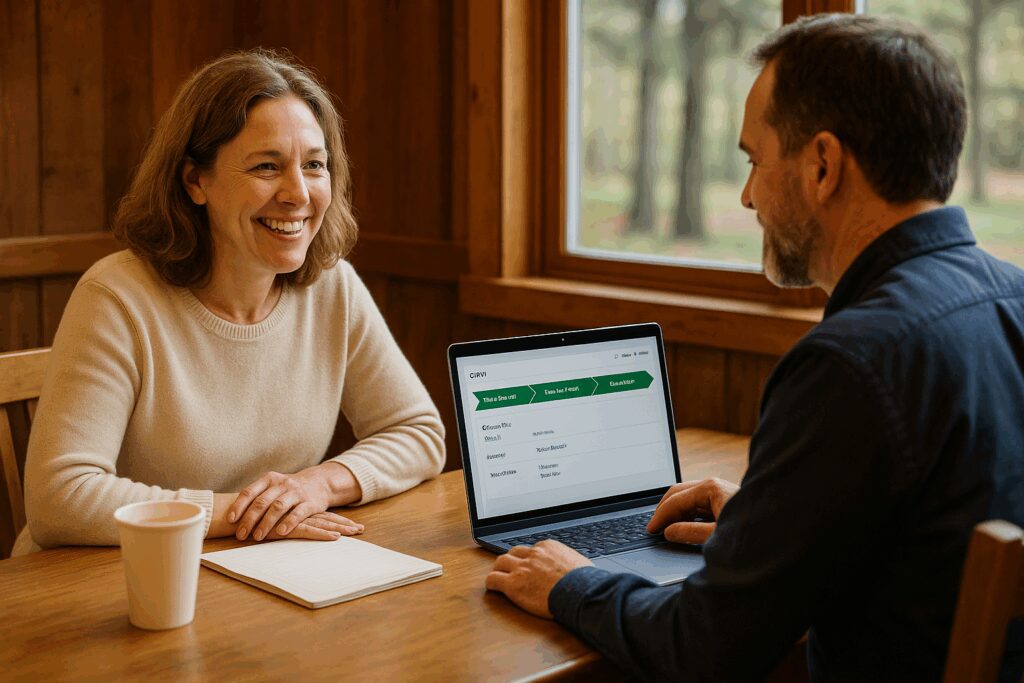
Sales Pipeline Automation Planning Worksheet
Before you can plan automations, it helps to have a clear picture of your sales process itself. That topic was covered in an earlier focus area article, along with a Sales Process Mapping Worksheet to help you define the major steps from inquiry to booking. If you haven’t completed that yet, we recommend starting there so you have a strong foundation.
Once your process is mapped, the Sales Pipeline Automation Planning Worksheet helps you take the next step: identifying where CRM automation can make it smoother and more reliable. This tool walks you through:
- Evaluating which pipeline stages are outcome-based and automation-friendly.
- Mapping the triggers (like a form submission, signed contract, or field update) that should move opportunities forward.
- Identifying which communications (emails, texts, reminders) should be automated.
- Assigning ownership for human follow-up when automation isn’t enough.
By the time you’ve completed this worksheet, you’ll have a practical plan for how your CRM can do more of the heavy lifting—keeping sales opportunities moving, ensuring no inquiries are lost, and giving you higher confidence in your follow-up.
📥 Download the Sales Pipeline Automation Planning Worksheet
By working through this worksheet, you’ll create a clear, step-by-step plan for how automation can support your retreat center’s sales, coordination, and rebooking processes. Instead of relying on memory or manual tracking, you’ll know exactly which actions should trigger progress and what communications or reminders will happen automatically. This not only saves time for your staff but also ensures a smoother, more consistent experience for every group you serve.
Mini Case Study
At one Christian conference center, the guest services team was responsible for everything—handling inquiries, booking retreats, coordinating details, and encouraging rebookings. Their process was sound, but it relied heavily on staff memory, worksheets, and email templates. While this worked for a time, staff transitions raised concerns about knowledge transfer and consistency.
They decided to adopt a CRM with a fully built-out sales pipeline, custom fields, email templates, and workflow automations. We helped them design a pipeline aligned to their existing sales process and created custom fields to capture key information at each stage. Pipeline progressions and field updates were then tied to automations that sent timely email reminders to retreat organizers, including links to forms for lodging assignments, meal plans, and final headcounts.
The result was a system that supported the team’s familiar process while making it easier for new staff to step in with confidence. As they grew comfortable with the CRM, the team began introducing additional improvements, including pipeline reporting tools to track inquiry volume, monitor bookings in progress, and measure conversion rates. Over time, the CRM became not just a tool for consistency, but also a foundation for better decision-making and more effective guest care.
Putting It All Together
CRM automation is most powerful when pipelines are outcome-based. With sales pipelines, stages like Proposal Sent and Contract Signed ensure deals advance automatically. With coordination pipelines, outcomes like Meals Confirmed and Final Numbers Received keep retreats on track. With rebooking pipelines, stages like Awaiting Rebooking Decision and Rebooked help you secure commitments faster.
The payoff? Predictability. Instead of wondering whether next spring will be full, you’ll see opportunities moving through your CRM pipelines. That peace of mind lets you focus on ministry, not uncertainty.
Here are some practical steps you can take right now:
- Define outcome-based stages for your sales, coordination, and rebooking pipelines (e.g., Proposal Sent, Meals Confirmed, Rebooked).
- Identify triggers that should move opportunities forward automatically, such as contract signatures or form submissions.
- Automate acknowledgments and reminders (emails, texts, or surveys) so communication happens consistently and on time.
- Set up internal notifications so staff are reminded of tasks at the right moment.
- Add custom fields in your CRM to capture retreat-specific details like dietary needs, lodging assignments, or headcounts.
- Start small by automating one or two transitions, then expand as your team gains confidence.
And remember—you don’t need to be a sales expert to use this. Start simple, build step by step, and watch as your team adapts. Once pipelines are running, most of the heavy lifting happens automatically.
Ready to Take the Next Step?
Streamlining your retreat pipeline with CRM automation means your team has a clear system to follow, your guests experience smooth communication, and your calendar becomes more predictable.
If you found this helpful, here are four great next steps to continue your journey:
🧭 Move to the Next Focus Area: Send Email & SMS Blasts
Learn how to send email and SMS blasts to stay top-of-mind with former guests and prospects.
[Read the Send Email & SMS Blasts Focus Area Article]
📘 Download the Retreat & Camp Growth Roadmap eBook
Get the full 3-stage system we use to help retreat centers and camps grow with clarity and purpose.
[Download the eBook]
🌱 Learn More About How We Help Retreat Centers & Camps
We’re a Christian-owned digital marketing agency that helps retreat centers and camps grow attendance, bookings, and impact through practical strategies rooted in clarity and stewardship.
[See How We Can Help]
🤝 Schedule a Free Discovery Call
Want help applying this to your unique situation? Let’s talk. We’ll explore where you are now, where you want to go, and how to take the next faithful step.
[Book a Discovery Call]
You don’t have to figure this out alone. Let’s build something meaningful—together.
Frequently Asked Questions
1. Why should pipeline stages be outcomes instead of tasks?
Outcome-based stages (like Final Numbers Received) can be tied to CRM triggers, so the system advances opportunities automatically when the outcome is met. Task-based stages require manual updates, which leads to errors and missed opportunities.
2. What is a retreat CRM pipeline?
It’s a structured process inside your CRM that tracks every opportunity—from inquiry to coordination to rebooking—using outcome-based stages that advance automatically as forms are submitted, fields updated, or contracts signed.
3. How does CRM automation save time?
By automating repetitive steps—acknowledgment emails, follow-up reminders, and stage updates—the CRM ensures every opportunity advances on schedule. Staff only step in when personal action is needed.
4. Can small retreat centers benefit from CRM automation?
Yes. Even with a small team, outcome-based pipelines reduce manual tracking and help ensure nothing is overlooked. Choosing a CRM with built-in automation features, such as LeadHub CRM, makes this process simple and scalable for any size retreat center.
5. What details can a CRM track for retreats?
Custom fields can store outcomes like lodging assignments, meal selections, AV requests, and headcounts. When updated, they can automatically trigger pipeline progression. LeadHub CRM, for example, allows you to build these fields directly into your process.
6. How does CRM automation support Christian camp marketing?
By improving efficiency, every inquiry generated by your marketing has a higher chance of converting into a booking. Data in the CRM also supports targeted outreach in future Christian camp digital marketing campaigns.
7. Can CRM automation improve SEO for camps?
Indirectly, yes. Smooth processes mean happier guests, which leads to more reviews and referrals. Positive reviews boost local SEO for retreat centers and camps.
8. Is automation too impersonal for ministry?
Not if used wisely. Automation handles routine steps, freeing staff to focus on personal, ministry-centered interactions.
9. How do we get staff comfortable with CRM pipelines?
Start with outcome-based stages that match their daily workflow. Once they see how automation reduces their workload, they’ll embrace it. Choosing a user-friendly platform like LeadHub CRM helps staff adopt the system quickly.
10. What’s the first step to get started?
Map your current process, define the outcomes that matter most, and set up your CRM pipeline with stages tied to those outcomes. If you don’t have a CRM yet, consider LeadHub CRM—it’s designed with retreat centers in mind and offers powerful automation features that make this transition smoother.
11. Why do you recommend LeadHub CRM?
LeadHub CRM combines robust automation tools with deep integration into its pipeline features. It supports outcome-based stages, automates communications, and syncs with third-party tools like payment systems and email platforms. For retreat centers, this means fewer dropped details, easier coordination, and more consistent rebookings—all in one streamlined system.

